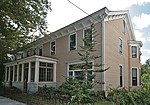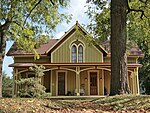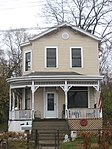Bates Building

The Bates Building is a historic house in the Columbia-Tusculum neighborhood of Cincinnati, Ohio, United States. A two-story building constructed in a vernacular style of architecture, it is one of the oldest buildings on Eastern Avenue in the neighborhood.Constructed in 1865, the Bates Building is a simple frame building with a gabled roof of shingles; it is three bays wide, and each side is a single bay. A significant exception to the house's simple construction is the ornate front porch, which appears to have been built after the rest of the house; complicated beveled woodwork covers the pillars of the porch. The eastern side of the house is otherwise the most distinctive part of the building; an outward projection on that side is the only exception to the house's rectangular shape, and included in the projection is a small oval window, which is the only non-rectangular window in the house.In 1979, the Bates Building was listed on the National Register of Historic Places due to its historically significant architecture. It was one of seventeen Columbia-Tusculum properties included in a multiple property submission related to a historic preservation survey that had been conducted in the previous few years; most of the properties were buildings, but the Columbia Baptist and Fulton-Presbyterian Cemeteries were also included.
Excerpt from the Wikipedia article Bates Building (License: CC BY-SA 3.0, Authors, Images).Bates Building
Eastern Avenue, Cincinnati Columbia-Tusculum
Geographical coordinates (GPS) Address Nearby Places Show on map
Geographical coordinates (GPS)
| Latitude | Longitude |
|---|---|
| N 39.111111111111 ° | E -84.435555555556 ° |
Address
Eastern Avenue & Donham Avenue
Eastern Avenue
45226 Cincinnati, Columbia-Tusculum
Ohio, United States
Open on Google Maps











